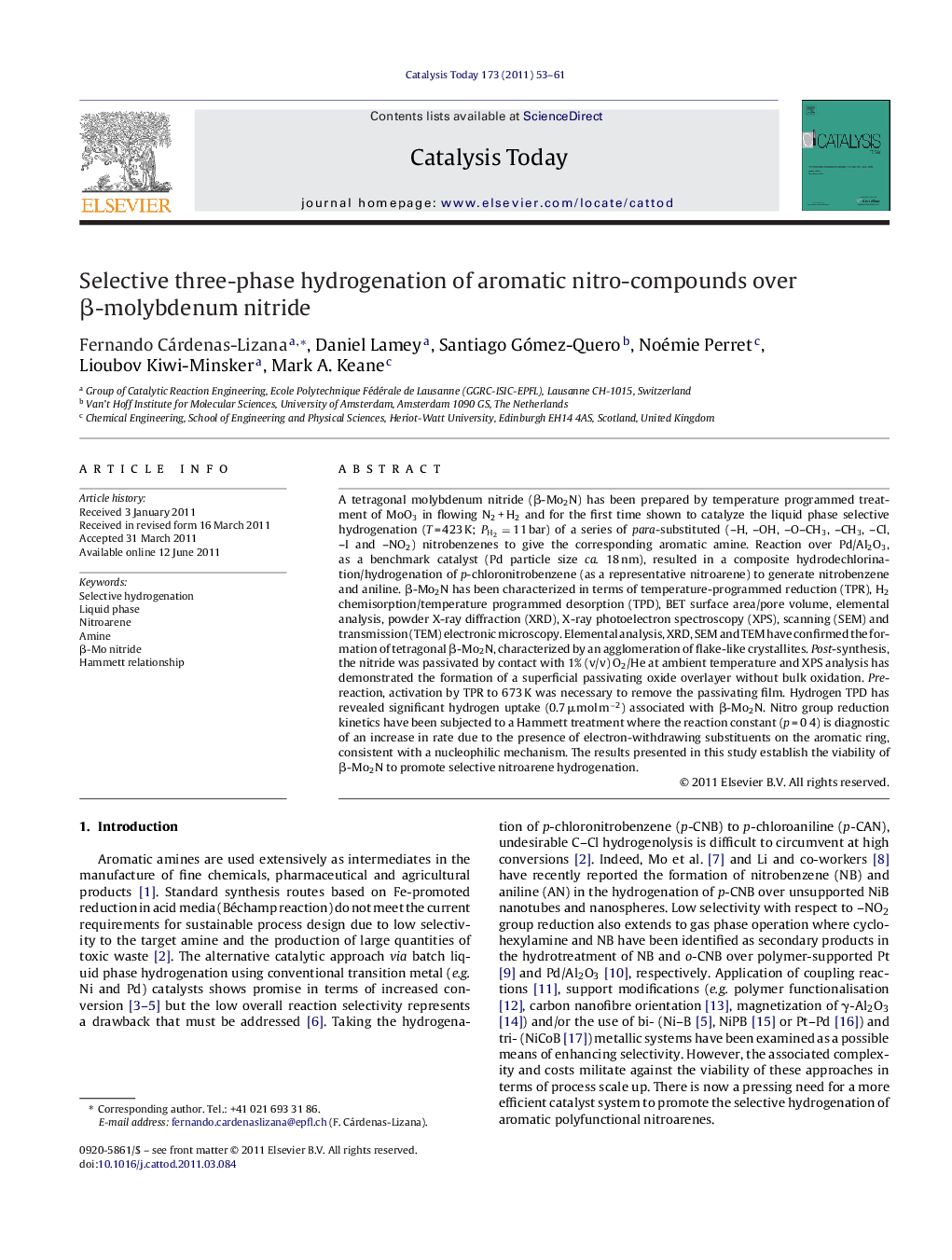| کد مقاله | کد نشریه | سال انتشار | مقاله انگلیسی | نسخه تمام متن |
|---|---|---|---|---|
| 55969 | 47067 | 2011 | 9 صفحه PDF | دانلود رایگان |

A tetragonal molybdenum nitride (β-Mo2N) has been prepared by temperature programmed treatment of MoO3 in flowing N2 + H2 and for the first time shown to catalyze the liquid phase selective hydrogenation (T = 423 K; PH2=11 barPH2=11 bar) of a series of para-substituted (–H, –OH, –O–CH3, –CH3, –Cl, –I and –NO2) nitrobenzenes to give the corresponding aromatic amine. Reaction over Pd/Al2O3, as a benchmark catalyst (Pd particle size ca. 18 nm), resulted in a composite hydrodechlorination/hydrogenation of p-chloronitrobenzene (as a representative nitroarene) to generate nitrobenzene and aniline. β-Mo2N has been characterized in terms of temperature-programmed reduction (TPR), H2 chemisorption/temperature programmed desorption (TPD), BET surface area/pore volume, elemental analysis, powder X-ray diffraction (XRD), X-ray photoelectron spectroscopy (XPS), scanning (SEM) and transmission (TEM) electronic microscopy. Elemental analysis, XRD, SEM and TEM have confirmed the formation of tetragonal β-Mo2N, characterized by an agglomeration of flake-like crystallites. Post-synthesis, the nitride was passivated by contact with 1% (v/v) O2/He at ambient temperature and XPS analysis has demonstrated the formation of a superficial passivating oxide overlayer without bulk oxidation. Pre-reaction, activation by TPR to 673 K was necessary to remove the passivating film. Hydrogen TPD has revealed significant hydrogen uptake (0.7 μmol m−2) associated with β-Mo2N. Nitro group reduction kinetics have been subjected to a Hammett treatment where the reaction constant (p = 0 4) is diagnostic of an increase in rate due to the presence of electron-withdrawing substituents on the aromatic ring, consistent with a nucleophilic mechanism. The results presented in this study establish the viability of β-Mo2N to promote selective nitroarene hydrogenation.
β-Mo2N prepared by temperature programmed treatment of MoO3 in N2 + H2 (BET = 7 m2 g−1; pore volume = 0.02 cm3 g−1; H2-TPD = 0.7 μmol m−2) has been used to promote selective –NO2 group reduction in the (liquid phase) hydrogenation of a series of para-substituted (–H, –OH, –OCH3, –CH3, –Cl, –I and –NO2) nitrobenzenes; a Hammett analysis (reaction constant (ρ) = 0.4) is consistent with a nucleophilic mechanism.Figure optionsDownload high-quality image (274 K)Download as PowerPoint slideHighlights
► First application of tetragonal molybdenum nitride (β-Mo2N) in the batch liquid phase selective hydrogenation of para-substituted nitrobenzenes.
► Temperature programmed desorption established a significant quantity of hydrogen (0.7 μmol m−2) associated with activated β-Mo2N.
► β-Mo2N outperformed Pd/Al2O3 in selective −NO2 group reduction.
► Reaction over β-Mo2N proceeded via a nucleophilic mechanism where electron withdrawing ring substituents elevated rate, as demonstrated by a linear Hammett relationship and positive reaction constant (ρ = 0.4).
Journal: Catalysis Today - Volume 173, Issue 1, 1 September 2011, Pages 53–61